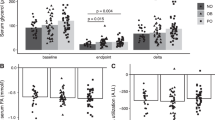Abstract
OBJECTIVE: The weight loss achieved during treatment with very-low-calorie diets (VLCD) varies between individuals. The aim of this study was to investigate whether interindividual variations in catecholamine-induced lipolysis are of importance for the rate of weight loss during VLCD. DESIGN: Prospective study. SUBJECTS: Twenty-eight obese, but otherwise healthy and drug-free women aged 20–57 y with BMI 33.3–47.5 kg/m2 were investigated before entering a four week weight reduction program with a calorie-restricted diet. MEASUREMENTS: A subcutaneous adipose tissue biopsy was obtained from the abdominal area. Isolated fat cells were prepared and incubated in vitro with agents acting on lipolysis at defined steps in the lipolytic cascade. Glycerol release was measured and used as a lipolytic index. Following the biopsy, the subjects underwent a four week VLCD treatment. RESULTS: The decrease in body weight in the whole group ranged between 4.8 and 13.5 kg. Dietary compliance was ascertained by daily measurements of urine-ketones and regular interviews and was satisfactory in all subjects throughout the study. Based on percent body weight reduction, the material was divided into two equally sized groups, classified as rapid or slow weight losers. The rapid weight losers were 10-fold more sensitive to the lipolytic effect of noradrenaline (P=0.04) and 10-fold less sensitive (P=0.002) to the antilipolytic effect induced by the α2-adrenoceptor agonist clonidine than the slow weight losers. In the whole material, weight loss was significantly correlated (adjusted r2=0.25) with α2-adrenoceptor sensitivity. CONCLUSION: Rapid weight loss during VLDC is associated with increased adipocyte lipolytic sensitivity to catecholamines due to decreased α2-adrenoceptor sensitivity, which in turn may promote lipid mobilization. It appears that variations in α2-adrenoceptor sensitivity in adipocytes may be predictive of weight loss during VLCD.
This is a preview of subscription content, access via your institution
Access options
Subscribe to this journal
Receive 12 print issues and online access
$259.00 per year
only $21.58 per issue
Buy this article
- Purchase on Springer Link
- Instant access to full article PDF
Prices may be subject to local taxes which are calculated during checkout
Similar content being viewed by others
Author information
Authors and Affiliations
Rights and permissions
About this article
Cite this article
Hellström, L., Rössner, S., Hagström-Toft, E. et al. Lipolytic catecholamine resistance linked to α2-adrenoceptor sensitivity—a metabolic predictor of weight loss in obese subjects. Int J Obes 21, 314–320 (1997). https://doi.org/10.1038/sj.ijo.0800407
Received:
Revised:
Accepted:
Issue Date:
DOI: https://doi.org/10.1038/sj.ijo.0800407
Keywords
This article is cited by
-
Dysfonctions du système nerveux sympathique et de la signalisation catécholaminergique chez l’obèse
Obésité (2014)
-
Weight loss and regain in obese individuals: a link with adipose tissue metabolism indices?
Journal of Physiology and Biochemistry (2013)
-
β3-Adrenoceptor function and long-term changes in body weight
International Journal of Obesity (2009)
-
Polymorphism of the adrenergic receptor alpha 2a −1291C>G genetic variation and clozapine-induced weight gain
Journal of Neural Transmission (2005)
-
Relationship between sympathetic reactivity and body weight loss in morbidly obese subjects
International Journal of Obesity (2004)



